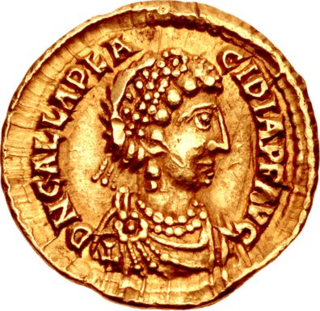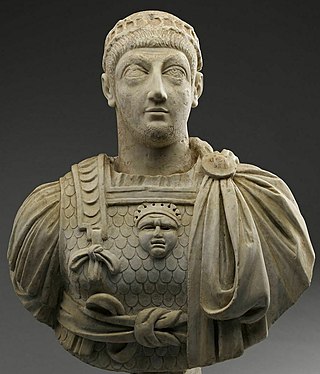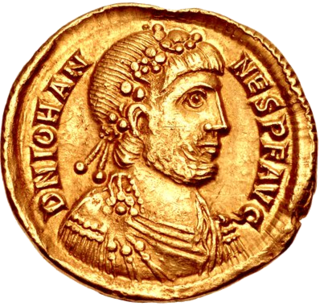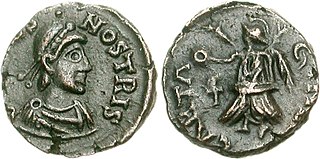Related Research Articles

Honorius was Roman emperor from 393 to 423. He was the younger son of emperor Theodosius I and his first wife Aelia Flaccilla. After the death of Theodosius in 395, Honorius, under the regency of Stilicho, ruled the western half of the empire while his brother Arcadius ruled the eastern half. His reign over the Western Roman Empire was notably precarious and chaotic. In 410, Rome was sacked for the first time in almost 800 years.

Galla Placidia, daughter of the Roman emperor Theodosius I, was a mother, tutor, and advisor to emperor Valentinian III. She was queen consort to Ataulf, king of the Visigoths from 414 until his death in 415, briefly empress consort to Constantius III in 421, and managed the government administration as a regent during the early reign of Valentinian III until her death.

Pope Boniface I was the bishop of Rome from 28 December 418 to his death on 4 September 422. His election was disputed by the supporters of Eulalius until the dispute was settled by Emperor Honorius. Boniface was active in maintaining church discipline, and he restored certain privileges to the metropolitical sees of Narbonne and Vienne, exempting them from any subjection to the primacy of Arles. He was a contemporary of Augustine of Hippo, who dedicated to him some of his works.
The 400s decade ran from January 1, 400, to December 31, 409.
The 420s decade ran from January 1, 420, to December 31, 429.

Year 414 (CDXIV) was a common year starting on Thursday of the Julian calendar. At the time, it was known as the Year of the Consulship of Constantius and Constans. The denomination 414 for this year has been used since the early medieval period, when the Anno Domini calendar era became the prevalent method in Europe for naming years
The 410s decade ran from January 1, 410, to December 31, 419.

Valentinian III was Roman emperor in the West from 425 to 455. Made emperor in childhood, his reign over the Roman Empire was one of the longest, but was dominated by powerful generals vying for power amid civil wars and the invasions of Late antiquity's Migration Period, including the campaigns of Attila the Hun.

Aetius was a Roman general and statesman of the closing period of the Western Roman Empire. He was a military commander and the most influential man in the Empire for two decades (433–454). He managed policy in regard to the attacks of barbarian federates settled throughout the West. Notably, he mustered a large Roman and allied (foederati) army in the Battle of the Catalaunian Plains, ending a devastating invasion of Gaul by Attila in 451, though the Hun and his subjugated allies still managed to invade Italy the following year, an incursion best remembered for the ruthless Sack of Aquileia and the intercession of Pope Leo I.

Constantius III was briefly Western Roman emperor in 421. He earned his position as Emperor due to his capability as a general under Honorius, achieving the rank of magister militum by 411. That same year, he suppressed the revolt of Constantine III, a Roman general who had declared himself emperor. Constantius then went on to lead campaigns against various barbarian groups in Hispania and Gaul, recovering much of both for the Western Roman Empire. Constantius married Honorius's sister Galla Placidia in 417, a sign of his ascendant status, and was proclaimed co-emperor by Honorius on 8 February 421. He reigned for seven months before dying on 2 September 421.

Joannes or John was western Roman emperor from 423 to 425.
Antipope Eulalius was antipope from December 418 to April 419. Elected in a dual election with Pope Boniface I, he eventually lost out to Boniface and became bishop of Napete.

Justa Grata Honoria was the daughter of Constantius III and Galla Placidia, as well as the sister of Valentinian III. In her life she had seen her family grasp and keep power, however she herself was given little power despite having the title of Augusta. This title meant that she could rule as regent in the case that Galla Placidia was not able to, however it also meant that she must take a vow of virginity and inability to marry. She found herself in many scandals, in which the punishments led her to send a letter to Attila the Hun asking for him to invade on her behalf, which is often interpreted as a proposal.

Bonifatius was a Roman general and governor of the diocese of Africa. He campaigned against the Visigoths in Gaul and the Vandals in North Africa. An ally of Galla Placidia, mother and advisor of Valentinian III, Bonifacius engaged in Roman civil wars on her behalf against the generals Felix in 427-429 and Aetius in 432. Although he defeated the latter at the Battle of Rimini, Bonifacius suffered a fatal wound and was succeeded by his son-in-law Sebastianus as patricius of the Western Roman Empire.

The Theodosian dynasty was a Roman imperial family that produced five Roman emperors during Late Antiquity, reigning over the Roman Empire from 379 to 457. The dynasty's patriarch was Theodosius the Elder, whose son Theodosius the Great was made Roman emperor in 379. Theodosius's two sons both became emperors, while his daughter married Constantius III, producing a daughter that became an empress and a son also became emperor. The dynasty of Theodosius married into, and reigned concurrently with, the ruling Valentinianic dynasty, and was succeeded by the Leonid dynasty with the accession of Leo the Great.

The Mausoleum of Galla Placidia is a Late Antique Roman building in Ravenna, Italy, built between 425 and 450. It was added to the World Heritage List together with seven other structures in Ravenna in 1996. Despite its common name, the empress Galla Placidia was not buried in the building, a misconception dating from the thirteenth century; she died in Rome and was buried there, probably alongside Honorius in the Mausoleum of Honorius at Old Saint Peter's Basilica.
Placidia was a daughter of Valentinian III, Roman emperor of the West from 425 to 455, and from 454/455 the wife of Olybrius, who became western Roman emperor in 472. She was one of the last imperial spouses in the Roman west, during the Fall of the Western Roman Empire during Late Antiquity.

The Valentinianic or Valentinian dynasty was a ruling house of five generations of dynasts, including five Roman emperors during Late Antiquity, lasting nearly a hundred years from the mid fourth to the mid fifth century. They succeeded the Constantinian dynasty and reigned over the Roman Empire from 364 to 392 and from 425 to 455, with an interregnum (392–423), during which the Theodosian dynasty ruled and eventually succeeded them. The Theodosians, who intermarried into the Valentinian house, ruled concurrently in the east after 379.

Gothic revolt of Theodoric I was an uprising of the Gothic Fouderati in Aquitaine during the regime of Emperor Valentinian III (425-455). That rebellion was led by Theodoric I, King of the Visigoths and took place in the South of France. The uprising took place between 425 and 426, in the period shortly after the death of usurpator John and was terminated by a military procedure under the command of Aëtius.

The Roman Civil War of 425 was a short civil war between the West Roman Emperor Joannes and the East Roman Emperor Theodosius II. After rising tensions, battles took place in Italy between the armies of both halves of the empire. Despite this, the conflict did not end by battle, but as a result of a conspiracy in which the Western emperor was captured and killed shortly afterwards.
References
- ↑ Stewart Oost, Galla Placidia Augusta (Chicago: University Press, 1968), pp. 172f.
- 1 2 Matthews, Western Aristocracies and Imperial Court AD 364 - 425 (Oxford: Clarendon Press, 1990), p. 379
- ↑ Oost, Galla Placidia Augusta, pp. 178f. Oost follows Ernst Stein's identification of the consul of 424 with the Patrician; see p. 179 n. 35 for the bibliography of the discussion.
- ↑ Matthews, Western Aristocracies, p. 380; Oost, Galla Placidia Augusta, pp. 183 - 189
- 1 2 Oost, Galla Placidia Augusta, p. 190
- ↑ Matthews, Western Aristocracies, p.381